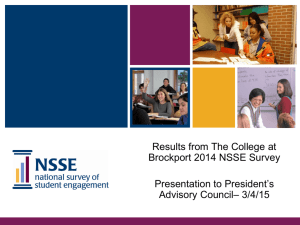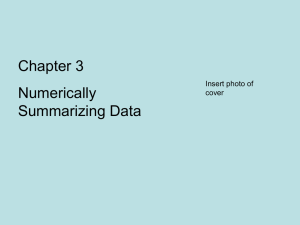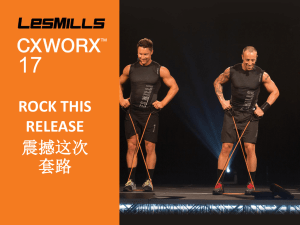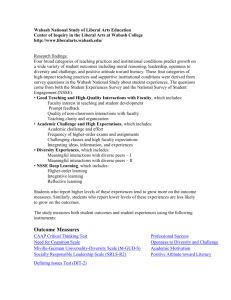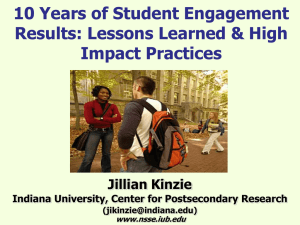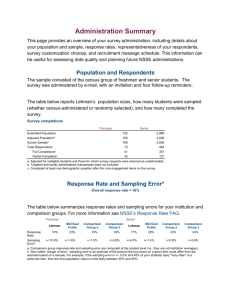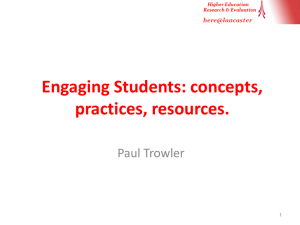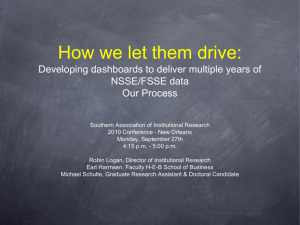Jillian Kinzie 'Academically Adrift'
advertisement
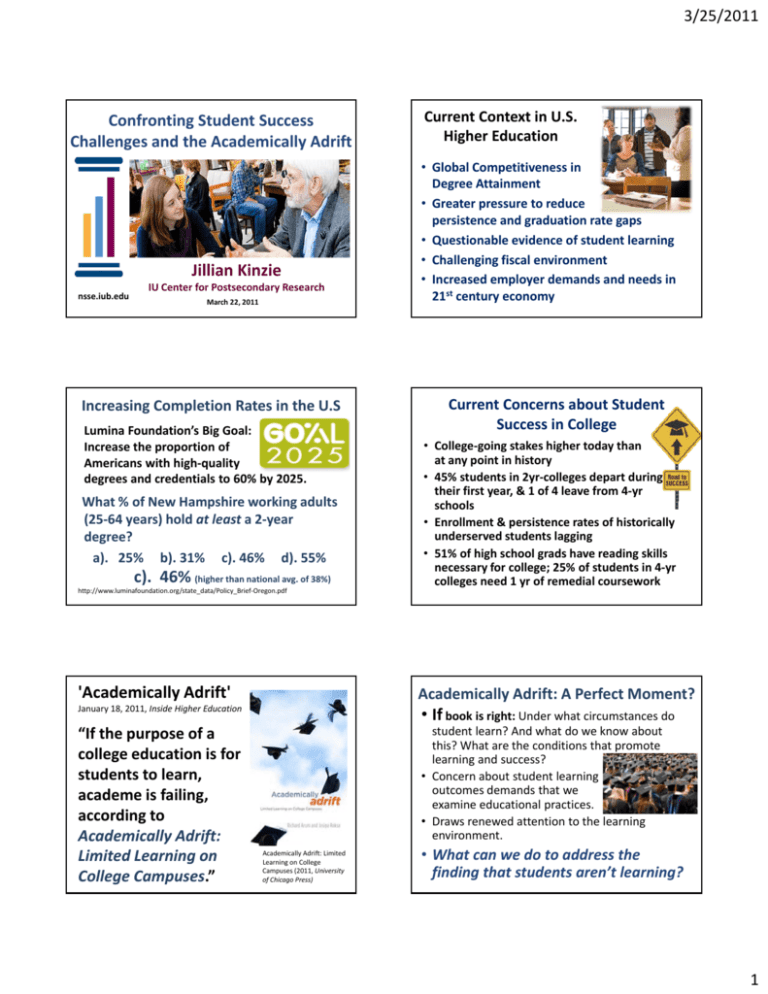
3/25/2011 Confronting Student Success Challenges and the Academically Adrift Jillian Kinzie nsse.iub.edu IU Center for Postsecondary Research March 22, 2011 Increasing Completion Rates in the U.S Lumina Foundation’s Big Goal: Increase the proportion of Americans with high‐quality degrees and credentials to 60% by 2025. What % of New Hampshire working adults (25‐64 years) hold at least a 2‐year degree? a). 25% b). 31% c). 46% d). 55% c). 46% (higher than national avg. of 38%) http://www.luminafoundation.org/state_data/Policy_Brief‐Oregon.pdf 'Academically Adrift' Current Context in U.S. Higher Education • Global Competitiveness in Degree Attainment • Greater pressure to reduce p persistence and graduation rate gaps • Questionable evidence of student learning • Challenging fiscal environment • Increased employer demands and needs in 21st century economy Current Concerns about Student Success in College • College‐going stakes higher today than at any point in history • 45% students in 2yr‐colleges depart during y , y their first year, & 1 of 4 leave from 4‐yr schools • Enrollment & persistence rates of historically underserved students lagging • 51% of high school grads have reading skills necessary for college; 25% of students in 4‐yr colleges need 1 yr of remedial coursework Academically Adrift: A Perfect Moment? January 18, 2011, Inside Higher Education • If book is right: Under what circumstances do “If the purpose of a college education is for students to learn, academe is failing, according to Academically Adrift: Limited Learning on College Campuses.” student learn? And what do we know about this? What are the conditions that promote learning and success? • Concern about student learning outcomes demands that we examine educational practices. • Draws renewed attention to the learning environment. Academically Adrift: Limited Learning on College Campuses (2011, University of Chicago Press) • What can we do to address the finding that students aren’t learning? 1 3/25/2011 We know a lot about What Matters to Student Learning & Success Student Behaviors & Activities Associated with Student Persistence & Success • Faculty‐Student Contact (important for The challenge is using what we know. Aligning resources, removing impediments, to optimize success for all students. first‐gen, racial‐ethnically diverse students) • Peer Interactions (meaningful connections, peer teaching, tutoring) • Experiences with Diversity (transforming for students) • Co‐curricular Activities (really important for persistence) • Student Satisfaction (influences sense of belonging) www.nces.ed.gov/npec/pdf/Kuh_Team_Report.pdf Think About Your Campus Learning Environment What We Know About Student Learning and Success Educators must be concerned with the learning environment – in and outside the classroom, socio‐cultural aspects and physical settings – d h i l i i in which students interact with peers, the content, educators and others, and the implementation of strategies that help guide the student toward the intended outcomes. 9 …How Prominent are the Key Features of Educationally Effective Environments? 1. Learning‐centered practice 2. Engaging, experiential learning 3. Enriched environments 4. Shared responsibility 5. Student agency 6. Learning outcomes & assessment 1. Learning‐Centered Practice • Promotion of seamless learning – student learning has the potential to result from virtually all student experiences • Shared mission and learning goals between student & academic affairs between student & academic affairs • Learning Reconsidered (2004) calls for greater integration of resources to educate and prepare the whole student and raise the quality of learning 2 3/25/2011 Purposeful Pathways to Transformational Learning A transformative education repeatedly exposes students to multiple opportunities for intentional learning through the intentional learning through the formal academic curriculum, student life, collaborative curricular programming, community‐based, and global Learning Reconsidered (2004) experiences. 3. Enriched Environments • Physical environment used to maximum educational advantage – to encourage peer, faculty, staff interaction, showcase student learning & l d h leadership… • Connect to the local community in mutually beneficial, educationally purposeful ways • Emphasize “high‐impact” practices –service‐ learning, undergraduate research, first‐year seminars – and ensure all students take part 5. Student Agency • Emphasis on student empowerment, initiative • Policies and structures facilitate student ownership 2. Engaging, Experiential Learning • Philosophy of learning with characteristic pedagogies/ activities • Demands students invest high levels of time & effort high levels of time & effort • Blends in & outside classroom experiences • Ample opportunities to apply learning to real‐ world contexts • Emphasizes reflection and integration 4. Shared Responsibility • Robust partnership between academic & student affairs • Everyone is an educator 6. Learning Outcomes & Assessment • Learning outcomes ‐ What students accomplish by participating in your program ‐ are explicit • Should be able to answer: “What is the educative value of this program or policy?” • Assessment data used to improve quality and effectiveness 3 3/25/2011 Educationally Effective Learning Environments 1. To what extent are the features of effective learning environments present on your campus? In your sphere h of influence? 2. What does this emphasis demand of current practice? Engaged learning is a gateway to the desired outcomes of college. Students who engage more frequently in educationally purposeful activities both in & outside the classroom get better grades, are more satisfied, and are more likely to persist more satisfied, and are more likely to persist and graduate. Who’s more engaged? Women Full‐time students Students who live on campus y Students with diversity experiences Students who start and stay at same school Students who have done Students who have done ““high high‐‐ impact”” practices impact Resources • National Survey of Student Engagement (NSSE) – results from first‐year students & seniors at 1,400 institutions • Student Success in College Student Success in College (2005, 2010) – documents what 20 high‐performing institutions do to promote student success • AAC&U and Kuh’s (2008) High‐ Impact Educational Practices Engaged Learning • Demands students invest high levels of time and effort • Ample opportunities to apply learning to real‐world contexts • Emphasizes reflection and integration Findings from NSSE and AAC&U: Some Educational Activities are Unusually Effective Growing evidence that “high‐ impact practices” provide impact practices provide substantial educational benefits to students [AAC&U, 2008 publication: High‐Impact Educational Practices: What They Are, Who Has Access To Them, and Why They Matter] 4 3/25/2011 HIPs Resources High‐Impact Practices Educational experiences that make a significant difference to student persistence, learning outcomes, and student success. 1. Pedagogical practices 2. Structural features • Five High‐Impact Practices (Brownell & Swaner, 2010) monograph examines body of research on five high‐impact practices: first‐year seminars, learning communities, service learning, undergraduate research & capstones. – Outcomes; – Outcomes for traditionally underserved populations; – Conditions under which positive outcomes are more likely to be found; – Strengths and weaknesses of outcomes literature. www.aacu.org High‐Impact Pedagogical Practices in the First Year • • • • • • • • • • • • Asked questions in class or contributed to class discussions Made a class presentation Prepared two or more drafts of a paper or assignment Worked with other students on projects during class Worked with classmates outside of class on assignments Tutored or taught other students (paid or voluntary) Participated in a community‐based project as part of course Talked about career plans with a faculty member or advisor Discussed ideas from readings/classes with faculty outside class Received prompt feedback on your academic performance Worked harder than you thought Worked with faculty on activities outside coursework (committees, student life, etc.) • Discussed ideas from readings/classes with others • Had serious conversations with students of a different race or ethnicity and those who differ from you ‐ religious beliefs, political opinions, or personal values To Ponder: How might you ensure that students – particularly in their first year – understand the value of high‐impact of high impact pedagogical pedagogical practices? And that more students experience these practices? High Impact Pedagogical Practices • Students who engage in these practices at high levels are more likely to persist and do well. –To what extent have your first‐year T h t t th fi t students had these experiences? What practices have you emphasized in your course, office, programs? High Impact Activities First First‐‐Year Seminars and Experiences Common Intellectual Experiences Learning Communities Writing Writing‐‐Intensive Courses Collaborative Assignments and Projects Collaborative Assignments and Projects Undergraduate Research Diversity/Global Learning Service Learning, Community‐‐Based Learning Community Internships Capstone Courses/ Projects 5 3/25/2011 Check‐in: High Impact Activities How many of these activities exist for your students? Do most students take advantage of these practices? advantage of these practices? Benefits of High Impact Practices High Impact practices are positively associated with: • Persistence and GPA • Higher rates of student‐faculty interaction Hi h f d f l i i • Increases in critical thinking, writing skills, • Greater appreciation for diversity • Higher student engagement overall Bronwell, J & Swaner, L (2009). High Impact Practices: Applying the Learning Outcomes Literature; Kuh (2008) Lessons from NSSE about Structural HIPs • Learning Communities –programs that integrate material across courses associated with higher student engagement & learning • Study Abroad ‐ length of time abroad did not make a difference; first‐gen students less likely to go abroad Service‐Learning • Positively associated with deep learning and personal development • Fewer Males • Most beneficial feature: Community‐based project as part of a regular course • Undergraduate Research ‐ associated with higher levels of student‐faculty interaction and support Service Learning and Reflective Learning NSSE items – Reflective Learning Frequency of... Students (First‐ years & Seniors) ears & Seniors) who participated in service‐learning report more reflective learning experiences. Tried to better understand someone else's views else's views Learned something that changed understanding on a topic or issue Examined strengths & weaknesses of own view Never / Sometimes / Often / Very Often Service‐Learning Participation (NSSE 2010 results) 1. What proportion of first‐year students at 4‐year colleges have done service‐ learning? (a) 25% (b) 36% (c) 41% (d) 75% c. 41% (49% seniors) CCSSE reports about 22% 6 3/25/2011 Do All Students Experience High‐ Impact Practices? • Nope. High Impact Practices Only Reach A Fraction of Students OVERALL NSSE Participation Levels: First Year Students: First Year Students: Learning Communities Service Learning Seniors: Research With Faculty Internship Study Abroad FY Expectations?? p 16% 41% 19% 50% 16% FY Plan to Do: 33% 75% 42% First‐generation, racial‐ethnic, major differences too NSSE results, see “Annual Results” 37 Involvement in HIPs Varies Substantially by Major • Considerable differences in 4 largest‐enrollment majors: English, biology, business administration, & psychology. NSSE Annual Results 2010, Major Differences: Examining Student Engagement by Field of Study Percent of Service Learning by Major 1 2 3 4 5 6 7 8 9 10 11 12 13 14 15 Best Practices for Service Learning (Brownell & Swaner, 2010) Within Service‐Learning Programs • Create opportunities for structured reflection. • Ensure that faculty connect classroom p material with the service experience. • Require enough service hours to make the experience significant. • Focus on the quality of the service, ensuring that students have direct contact with clients. • Oversee activities at the service site. (% who responded at least “Sometimes”) Nursing 78% 16 Anthro Phys Ed. 75% 17 Econ Elem Ed 69% 18 ENGL Urban Plan 65% 19 Math Occup/PT 64% 20 Civil Engr. Sec Ed 61% 21 History Pharmacy 57% Industrial Engr 22 Industrial Engr. Health Tech 57% 23 BUSINESS ADM Ethnic Studies 53% 24 Chem PSYCH 51% 25 BioChem/BioPh BIO (gen) 47% 26 Acctg Poli Sci 47% 27 Botany Journalism 46% 28 Physics Finance 45% 29 Chem Engr. Art, fine, 43% 30 Elec Engr. 43% 43% 42% 42% 42% 41% 41% 41% 41% 40% 40% 36% 34% 34% 34% What to Do? Make it possible for every student to participate in at least two high impact activities One in First Year • • • FY seminars FY seminars Learning communities Service learning One Later in Major • • • • Study abroad Student‐faculty research Field placement or internship Capstone project 7 3/25/2011 Educationally Effective Institutions and High Impact Practices • Weave experiences into courses, and require • Introduce HIPs to students early – pre‐school and orientation ‐ and reinforce in advising • Craft short term study abroad, Craft short term study abroad “mini‐HIPs” mini‐HIPs • Emphasize HIPs relevant to the educational environment – i.e., Urban institutions emphasize Be Intentional about Exposing Students to Educationally Effective Practice internships • Encourage pilots & support faculty development • Bridge curriculum and co‐curriculum Considerations for Expanding Engagement in HIPs 1. Historically underrepresented students benefit substantially from HIPs, yet not all take part (First‐generation, some racial‐ethnic groups, transfer students) 2. Introduce Introduce HIPs early and often HIPs early and often ‐‐ get experience get experience on students radar 3. Explore students’ assumptions about practices (who participates, cost, demands, etc.) – debunk myths 4. How might student & academic affairs work together to make these experiences more widespread? To ponder: Transformational learning & student success 1. Which high‐impact practices are distinctive to your campus? Why? 2. How might opportunities for ALL students to participate in high‐impact t d t t ti i t i hi h i t practices be expanded? 3. What cross‐campus collaborations exist for service‐learning? 46 Discussion and Comments Jillian Kinzie, PhD. NSSE Institute Indiana University Center for Postsecondary Research 1900 East 10th Street Eigenmann Hall, Suite 419 Bloomington, IN 47406 Ph: 812‐856‐5824 Fax: 812‐856‐5150 jikinzie@indiana.edu www.nsse.iub.edu 8
